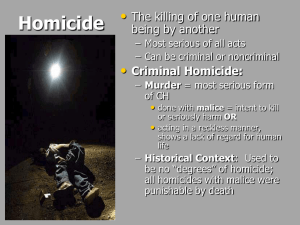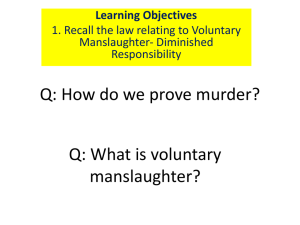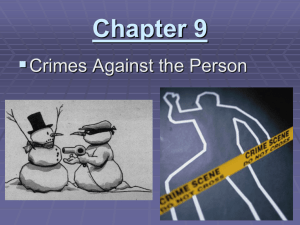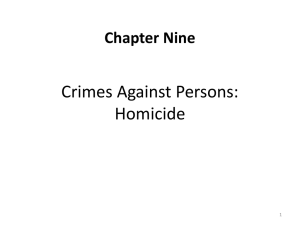Chapter 5
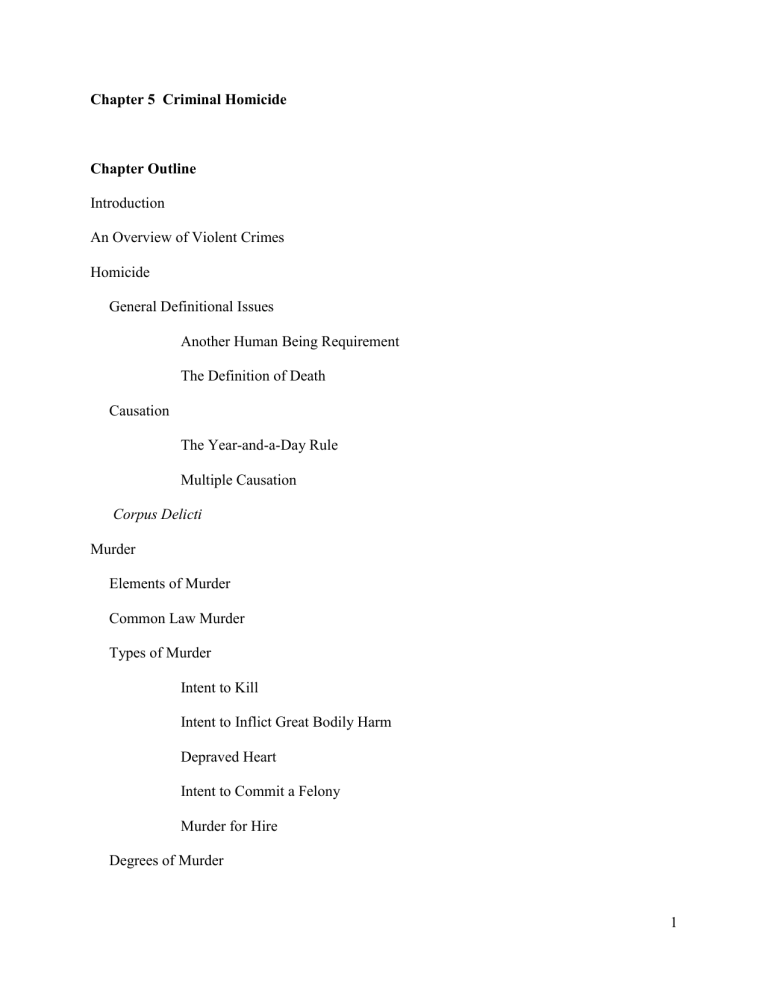
Chapter 5 Criminal Homicide
Chapter Outline
Introduction
An Overview of Violent Crimes
Homicide
General Definitional Issues
Another Human Being Requirement
The Definition of Death
Causation
The Year-and-a-Day Rule
Multiple Causation
Corpus Delicti
Murder
Elements of Murder
Common Law Murder
Types of Murder
Intent to Kill
Intent to Inflict Great Bodily Harm
Depraved Heart
Intent to Commit a Felony
Murder for Hire
Degrees of Murder
1
Lesser Included Offenses
Physician Assisted Suicide (PAS)
Manslaughter
Types of Manslaughter
Summary
Study Questions
Voluntary Manslaughter
Heat-of-Passion Manslaughter
Manslaughter in Domestic Relations
The Reasonable Person Standard
Involuntary Manslaughter
Misdemeanor or Negligent Manslaughter
Vehicular and DUI Manslaughter
Failure-to-Act Manslaughter
For Debate
Key Terms
Case Analysis
Internet Activity
Notes
Key Terms
2
Baby Moses laws: Laws protecting mothers and fathers who abandon their newborn and unwanted babies in ways that will ensure the health and safety of those infants.
Generally, these laws, which are spreading throughout the world, permit parents to leave the infants in safe places and avoid prosecution.
Corpus delecti : Means the “body of the crime” and refers to the body or other material substance of a crime that constitutes the foundation of that particular crime.
Corroborating evidence: Includes additional data to support the crime charged, especially in rape and other cases in which there were no witnesses to the alleged act, and it is crucial to proving a case.
Crime rate: The number of crimes per 100,000 in the population.
Crimes known to the police: All serious offenses that have been reported to the police and for which the police have sufficient evidence to believe that those crimes were actually committed.
Excusable homicide: A killing that is accidental or is the result of self-defense or other circumstances that the law permits.
Felony murder: An unlawful killing of a person that occurs while attempting to commit or while committing another felony, such as robbery, rape, or arson.
3
Fetal alcohol syndrome: A cluster of abnormalities that a fetus may have because its mother consumed alcohol during her pregnancy. The effects include growth deficiencies, facial abnormalities, and mental retardation.
Homicide: An inclusive term that refers to all cases in which human beings—by their own acts, omissions, or procurement—kill other human beings. Homicide may be criminal (murder, manslaughter, or negligent homicide) or noncriminal (committed with justification or excuse).
Infanticide: Killing of an infant at or soon after its birth.
Involuntary manslaughter: See Manslaughter.
Justifiable homicide: A killing that is intentional but carries no evil intention and is permitted by law, such as one involving capital punishment or a killing by a law enforcement officer in the line of duty when attempting to prevent a felony.
Lesser included offense: A crime less serious than the one with which a defendant is being charged.
Manslaughter: An unlawful killing without malice. It can be voluntary or involuntary.
Voluntary manslaughter is a killing that would be murder except that it was committed in the heat of passion for which there is a reasonable explanation or excuse. Involuntary manslaughter is a criminal homicide that is committed recklessly but unintentionally, as when one is under the
4
influence of alcohol or drugs. Negligent manslaughter is a killing that is not lawful or justified and involves no malice—only negligence.
Murder: The unlawful and unjustified killing of another human being (or a fetus in some jurisdictions) with malice aforethought. Types of murder include the intent to kill, the intent to do great bodily harm, an act done in willful disregard of the strong likelihood that death or great injury would result, or a killing committed during the commission of another felony.
Negligent manslaughter: See Manslaughter.
Per curiam: By the whole court; referring to an opinion written by the court and not by a named judge or justice.
Premeditation: The act of planning, deliberating, designing, or thinking out in advance an intention to kill another person.
Uniform Crime Reports (UCR): Official crime data, which is collected, compiled, and published by the Federal Bureau of Investigation (FBI) annually. The data are based on crimes known to the police—crimes that are reported to or observed by the police and that the police have reason to believe were committed. The report also publishes arrest data.
Violent crime: A crime defined by the FBI’s UCR as serious crimes against a person.
5
The four serious violent crimes in the UCR are murder and nonnegligent manslaughter, robbery, rape, and aggravated assault.
Voluntary manslaughter: See Manslaughter.
Chapter Overview
Fear of crime, particularly murder, is pervasive in our society. This fear has only increased since 11 September 2001. Shootings in schools, at universities, and on the streets only add to the fear.
Homicide is an inclusive term that covers a large number of offenses of varying kinds. Some do not carry any criminal liability at all. It is important to understand the rationale behind the distinctions and their implications for application.
The evolution of homicide over time has left differing definitions from state to state. Some states use the felony murder rule, others do not. Some states prosecute for fetal abuse, others do not. Understanding the various definitions is important to appreciate the policy differences and current debates in the field.
Most modern statutes divide murder into two categories: first-degree murder and seconddegree murder.
6
Physician-assisted suicide is a continuing debate. Is it an exception to murder?
The distinctions between homicide and manslaughter hold in most jurisdictions. It is critical to appreciate the differences within manslaughter statutes and between manslaughter and homicide generally.
Learning Objectives
After studying this chapter the student will:
1.
Be able to define homicide.
2.
Be able to discuss the requirement of “another human being.”
3.
Be able to discuss the problems with the definition of death.
4.
Be able to discuss the year-and-a-day rule in terms of causation.
5.
Be able to explain the term corpus delicti.
6.
Be able to name the elements of murder.
7.
Be able to name the different types of murder: intent to kill, intent to inflict great bodily harm, intent to commit a felony, depraved heart, and murder for hire.
8.
Know the degrees of murder.
9.
Know the lesser included offenses.
10.
Be able to discuss mercy killing.
11.
Be able to discuss physician-assisted suicide.
12.
Be able to differentiate between voluntary and involuntary manslaughter.
13.
Know the difference between excusable homicide and justifiable homicide.
7
Review Questions
1.
Define homicide.
2.
What does the requirement of “another human being” mean in the homicide statutes?
3.
What impact does medical science have on the definition of death in homicide cases?
4.
Explain the common law year-and-a-day rule, and discuss its usefulness in modern times.
5.
What does corpus delicti mean, and what is its importance in a case other than homicide where there is a deceased victim?
6.
What are the elements of murder?
7.
How do we classify murders?
8.
What evidence allows us to differentiate which degree of murder has been committed?
9.
What is the mens rea in depraved heart murder?
10.
Is murder a specific intent or general intent crime? Explain.
11.
Explain the difference between first-degree murder and manslaughter.
12.
What is the definition of “sudden passion”?
13.
Explain the difference between voluntary and involuntary manslaughter.
14.
Explain this statement: All murders are homicides, but not all homicides are murders.
15.
What is the mens rea required for the commission of voluntary manslaughter?
16.
What would the lesser included offenses to voluntary manslaughter include?
17.
What are excusable homicides?
18.
Give an example of an excusable homicide, and explain the defense employed that would put the “excuse” in issue.
8
19.
What is a justifiable homicide?
20.
Give an example of justifiable homicide.
21.
Discuss the issues surrounding mercy killing, specifically the consent issue.
22.
What jurisdictions statutorily allow physician-assisted suicide?
23.
Discuss the arguments both for and against physician-assisted suicide.
Multiple Choice Questions
1. The American Bar Association uses the term Baby Moses laws to describe which of the following? a. the willful killing of an unborn child by any injury to the mother of such child b. infanticide c. the changes in the common law requirement of being born alive to include the fetus within murder statutes d. a law system permitting persons to leave their newborns at so-called safe places and not be subject to criminal prosecution
2. Which of the following is an element of murder? a. There must be an unlawful act committed by a human being. b. The act must be accompanied by the requisite mens rea. c. The victim must be a living human being. d. All of these are elements of murder.
3. Depraved heart murders are: a. when one person shoots another person with the intention of scaring him or her.
9
b. killings that result from the extremely reckless conduct of the defendant. c. deaths that result from serious bodily injuries, even though there was no intent to kill. d. murders with an intent to kill.
4. An unlawful killing without malice aforethought is a: a. mercy killing. b. first-degree murder. c. homicide. d. manslaughter.
5. Which of the following is not a justifiable homicide? a. the carrying out of a death penalty b. a killing in self-defense c. the killing of another human being by an act or omission d. a police killing in the line of duty
6. Which of the following is defined as the “body of the crime”? a. corpus delicti b. dicta c. habeas corpus d. capias
7. What type of evidence is additional data used to support the crime charged? a. clear and convincing b. concrete c. circumstantial d. corroborating
10
8. The deaths of ________________ resulted in the Unborn Victims of Violence Act of 2004. a. Andrea Yates’s children b. Laci and Conner Peterson c. Eric Harris and Dylan Klebold d. Emily and Kathleen Benton
9. _______________ homicides involve some fault but not enough that the law considers them worthy of criminal culpability. a. Excusable b. Justifiable c. Reckless d. Intentional
10. Today, the definition of ____________ has become a critical issue in many homicide cases. a. life b. time c. death d. weapon
11. Which of the following is not an element of murder? a. There must be an unlawful act (or omission) committed by a human being. b. The victim must be a living human being. c. The act must be accompanied by the requisite mens rea. d. The motive of the actor.
12. Which type of murder is said to be the result of an abandoned and malignant heart, or wickedness?
11
a. murder for hire b. heat of passion c. depraved heart d. intent to kill
13. What requirement becomes an issue when a fetus dies as the result of a crime against a pregnant woman? a. living human being b. brutality c. murder d. child
14. An important element the prosecution must prove in homicide cases is that the alleged crime and not some other act caused the victim’s death. This is called ________________. a. causation b. intent c. negligence d. malice aforethought
15. Which of the following is used to avoid murder convictions when death occurs from simple injury? a. negligent manslaughter b. excusable homicide c. reckless homicide d. intent to commit great bodily harm
16. ____________________ refers to the act of planning, deliberating, designing, or thinking out
12
in advance an intention to kill another person. a. Premeditation b. Malice aforethought c. Intent d. Depraved heart
17. Which of the following states has a law tthat allows for physician-assisted suicide? a. Washington b. Oregon c. Montana d. Idaho
18. __________________ means “by the whole court.” a. En banc b. Dissent c. Per curiam d. Concur
19. ________________ refers to killing a child at or soon after its birth. a. Homicide b. Fetal alcohol syndrome c. Infanticide d. Manslaughter
20. ________________ refers to a cluster of abnormalities that a fetus may have because its mother consumed alcohol during her pregnancy. a. Homicide
13
b. Fetal alcohol syndrome c. Infanticide d. Manslaughter
Fill-in-the-Blank Questions
1. ____________________ Literally, “the body of the crime”; the body or other evidence that generally must be produced to prove a crime has occurred.
2. ___________________ A crime defined by the FBI’s
UCR as a serious crime against a person. The four such crimes in the UCR are murder and nonnegligent manslaughter, robbery, rape, and aggravated assault.
3. ___________________ is a criminal homicide that is committed recklessly but unintentionally, as when one is under the influence of alcohol or drugs.
4. ___________________ All serious offenses that have been reported to the police and for which the police have sufficient evidence to believe that those crimes were actually committed.
5. ____________________ Laws protecting mothers and fathers who abandon their newborn and unwanted babies in ways that will ensure the health and safety of those infants. Generally, these laws, which are spreading throughout the world, permit parents to leave the infants in safe places and avoid prosecution.
6. ____________________ An inclusive term that refers to all cases in which human beings—by their own acts, omissions, or procurement—kill other human beings. These crimes may be criminal (murder, manslaughter, or negligent homicide) or noncriminal (committed with
14
justification or excuse).
7. ____________________ Killing an infant at or soon after its birth.
8. ____________________ The act of planning, deliberating, designing, or thinking out in advance an intention to kill another person.
9. ____________________ A killing that is intentional but carries no evil intention and is permitted by law, such as one involving capital punishment or a killing by a law enforcement officer in the line of duty when attempting to prevent a felony.
10. ___________________ A crime less serious than the one with which a defendant is being charged. It does not require a separate charge for a guilty verdict because it is implied by the more serious crime.
11. ___________________ An unlawful killing without malice. It can be voluntary or involuntary.
12. ___________________ is a killing that would be murder except that it was committed in the heat of passion for which there is a reasonable explanation or excuse.
13. ___________________ Official crime data, which is collected, compiled, and published by the Federal Bureau of Investigation (FBI) annually.
14. ___________________ The unlawful and unjustified killing of another human being (or a fetus in some jurisdictions) with malice aforethought: the intent to kill, the intent to do great bodily harm, an act done in willful disregard of the strong likelihood that death or great injury would result, or a killing committed during the commission of another felony.
15. __________________ Causing the death of another by negligent acts.
16. __________________ By the whole court; referring to an opinion written by the court and not by a named judge or justice.
15
17. ___________________ Additional data to support the charge of a crime, especially in rape and other cases in which there were no witnesses to the alleged act.
18. ___________________ The number of crimes per 100,000 in the population.
19. __________________ A killing that is accidental or is the result of self-defense or other circumstances that the law permits.
20. __________________ An unlawful killing of a person that occurs while attempting to commit or while committing another felony, such as robbery, rape, or arson.
21. ___________________ This state statute defines homicide as excusable when the killing is
“committed by accident or misfortune in doing any lawful act by lawful means, without criminal negligence, or without any unlawful intent.”
22. ___________________ Refers to a cluster of abnormalities that a fetus may have because its mother consumed alcohol during her pregnancy.
23. ___________________ Term used by some jurisdictions because of the problems of distinguishing justifiable homicide from excusable homicide.
24. ___________________ Generally an embryo at 28 weeks (earlier in some jurisdictions) of development.
25. ___________________ The definition of this term has become a critical issue in many homicide cases, in part because of doctors’ ability to keep patients functioning with the aid of life-support systems.
Short Answer Questions
1. What is the key element in distinguishing between first-degree and second-degree murder?
2. Briefly explain what is meant by the heat of passion.
16
14. a
15. d
16. a
17. b
9. a
10. c
11. d
12. c
13. a
4. d
5. c
6. a
7. d
8. b
3. What was the U.S. Supreme Court’s ruling in regard to physician-assisted suicide?
4. In homicide cases today, why is it important for the word “death” to be defined?
5. Explain why the year-and-a-day rule was utilized in homicide cases.
ANSWER KEY
Multiple Choice Questions
1. d
2. d
3. b
17
18. a
19. c
20. b
Fill-in-the-Blank Questions
1. corpus delecti
2. violent crime
3. involuntary manslaughter
4. crimes known to the police
5. Baby Moses laws
6. homicide
7. infanticide
8. premeditation
9. justifiable homicide
10. lesser included offense
11. manslaughter
12. voluntary manslaughter
13. Uniform Crime Reports
14. murder
15. negligent manslaughter
16. per curiam
17. corroborating evidence
18. crime rate
18
19. excusable homicide
20. felony murder
21. Washington
22. fetal alcohol syndrome
23. criminal homicide
24. viable fetus
25. death
19
